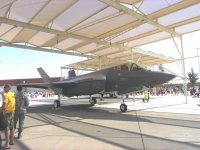BurmaShave said:
From my understanding, that's the F-35's game.
Indeed.
After this, it's a a shipborne livefire test.
Intro to a lengthy report from USNI follows. This changes one or two things if, down the road, it works in USN SAG/ARG service.
Successful F-35, SM-6 live fire test
By Sam LaGrone
September 13, 2016
A Monday test pairing a Lockheed Martin F-35B with an Aegis Combat System armed with a Raytheon Standard Missile-6 is the latest step in expanding how the Navy and Marine Corps will share data on future battlefields.
Using targeting information transmitted from the Marine Corps F-35B, the Navy’s Aegis test site at the White Sands Missile Range, New Mexico launched an SM-6 anti-air missile and struck a Beechcraft MQM-107 target representing an adversarial fighter.
The unmodified F-35 picked up the target with its own sensors and routed the track via the fighter’s Multifunction Advanced Data Link (MADL pronounced: MAHdel) to the Navy’s USS Desert Ship (LLS-1) test platform running the Baseline 9 Aegis Combat System. Lockheed and the Navy attached a MADL antenna to the combat system to receive the track information that fed the information to the SM-6.
The test is an expansion of the Navy’s Naval Integrated Fire Control-Counter Air concept (NIFC-CA) – a scheme designed to tie together data from the ships and aircraft in a carrier strike group to create a network of sensors and shooters – a proverbial kill web.
For example, targeting data collected from a Northrop Grumman E-2D Advanced Hawkeye can be beamed to a guided missile cruiser or destroyer in the strike group. That ship could then launch an SM-6 at the target only using the E-2s track and not its own radar.
For now, the E-2D remains the key node in the NIFC-CA program-of-record acting as the quarterback for the carrier’s air war but Monday’s test shows the Navy the art of the possible, said Anant Patel, major program manager for future combat systems in the Program Executive Office for Integrated Warfare Systems (PEO IWS) said in the conference call.
“This was a demonstration to show that within the NIFC-CA architecture we can add another sensor. As long as it meets the quality of service, we can engage the target,” Patel said. “We have F-18s, F-35s all of those sensors we have to consider and that’s a future effort we’re going to have to do as part of our NIFC-CA capability growth.”
The addition of the MADL to the mix of the program of record links NIFC-CA now uses – like Cooperative Engagement Capability (CEC) and Link-16 – the test is a move away from a carrier-centric construct.
F-35 and NIFC-CA
While the F-35 is billed and branded as a strike fighter, it also possesses a little discussed electronic warfare capability that gives it an exceptional awareness of its surroundings.
To that end NIFC-CA has included F-35 as a planned sensor node in carrier strike group model – acting as a stealthy forward arm but that would route targeting information back to the CSG through the E-2, USNI News reported in 2014.
However, using MADL direct to the Aegis ships weren’t part of the plan.
Link to the whole article, with images and a video, here - https://news.usni.org/2016/09/13/video-successful-f-35-sm-6-live-fire-test-points-expansion-networked-naval-warfare#more-21593






